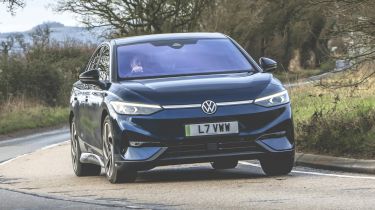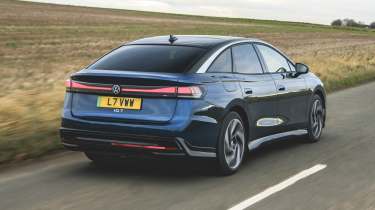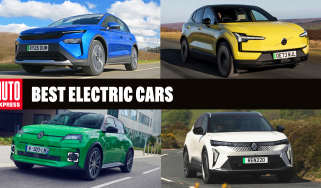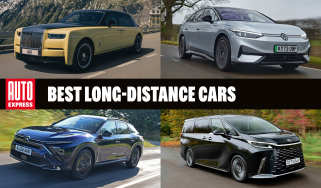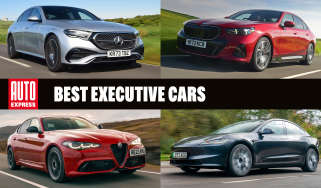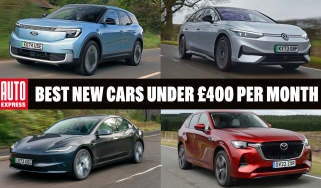New Volkswagen ID.7 Pro S boasts 437-mile range, but costs £5k more than rival Tesla Model 3
Prices for Volkswagen’s new flagship EV now start from £51,550, while long-range version is priced from £55,450
Volkswagen has launched a long-range version of its flagship EV, with the new Volkswagen ID.7 Pro S boasting a massive range of up to 437 miles – one of the longest claimed figures of any electric car sold in the UK, and trumping the 390-mile official range offered by the Tesla Model 3 Long Range.
However, the new ID.7 Pro S starts from £55,450, which is close to £5,500 more than its Model 3 rival and represents a nearly £4,000 price increase over the standard ID.7 fastback. The same is true for the ID.7 Tourer estate, which starts from £52,240, while the Pro S version comes in at £56,140.
Standard ID.7 Pro models use a 77kWh battery for an official range of up to 381 miles, or 373 miles in the ID.7 Tourer. The ID.7 Pro S meanwhile gets a larger 83kWh powerpack, boosting its range enough that it can drive from London to Edinburgh in one go, while it gets a maximum charging speed of 200kW, up from 175kW in the ID.7 Pro.
Both versions use a single electric motor to drive the rear wheels. It produces 282bhp and 545Nm of torque, which is enough to hit 62mph from a standstill in as little as 6.5 seconds, depending on the exact model.
Match trim is the only option for the ID.7, but every model comes generously equipped with 19-inch alloy wheels, LED headlights, a 15-inch central touchscreen, wireless Apple CarPlay and Android Auto, an augmented-reality head-up display, a wireless smartphone charging pad, heated front seats, 30-colour ambient lighting and keyless access. Numerous driver-assistance systems are standard-fit too, including adaptive cruise control, lane-change assist, driver-drowsiness monitoring and a rear-view camera.
Volkswagen ID.7 GTX
While the ID.7 Pro and Pro S are now available to order, still to come is the faster ID.7 GTX variant, which features a dual-motor, four-wheel drive setup producing 335bhp for 0-62mph in six seconds. It will also be offered as both a saloon and estate car.
To differentiate the ID.7 GTX for its lesser siblings, VW has applied some styling tweaks like new front and rear bumpers, a new daytime running light signature and darker trim around the dual-tone roof, plus 20-inch alloy wheels will be fitted as standard.
Volkswagen ID.7 design and dimensions
We first saw the ID.7 in concept form as the I.D. Vizzion back in 2018, then again as the ID. Aero in 2022. In terms of design, the family link between the ID.7 and cars such as the ID.4 SUV is clear. The design diverges at the rear, with a full-width light bar that appears white until lit. The ID.7 is best described as a ‘fastback’, with a sloping roof leading to a hatchback boot. The slippery shape provides a remarkably low drag coefficient of 0.23Cd that certainly plays a role in the ID.7’s large range figures.
The ID.7 measures 4,961mm long, 1,862mm wide and 1,536mm tall. In other words, it’s much longer than the Tesla Model 3, BMW i4 or Hyundai Ioniq 6, but roughly the same width and height as these three. Meanwhile, the ID.7’s MEB platform allows for a near-three-metre wheelbase, so there’s plenty of legroom and a flat floor in the rear. Further back, the large 532-litre boot has a moveable floor with storage underneath for cables.
Interior and infotainment
Inside, there are new ‘ergoActive’ electric seats that have been certified by the German Campaign for Healthier Backs, while an optional massage function features 10 adjustable air cushions. Clever adaptive climate control uses temperature and moisture sensors to find the best setting for either heating, cooling or even drying – handy if you get caught in a deluge on your way to the car.
A new 15-inch touchscreen is fitted, and this has the climate functions permanently positioned across the bottom of the display. Answering a common complaint about VW’s latest infotainment systems, the lower part of the bezel is backlit, so the temperature shortcuts and volume slider are now visible at night. The cabin can also be lit with a four-layer ambient lighting system, with multiple light patterns and colours to choose from.
It’s worth noting that there are no physical air vent controls. Instead, airflow is altered via the screen, while in some modes the car changes this automatically. Alternatively, owners can use the improved ‘IDA’ voice command system, with prompts such as “My hands are cold”. The speed, direction and temperature of airflow will be adjusted to suit.
Embedded in the ID.7’s minimalist dashboard is a small digital instrument cluster, which is similar to the set-up found in the Skoda Enyaq. Complementing the cluster is a standard-fit, augmented-reality head-up display, which appears to project features such as sat-nav instructions onto the road ahead. The optional panoramic sunroof contains a special ‘polymer-dispersed liquid crystal’, so it can become opaque or transparent at the touch of a button, while a 700-watt Harman Kardon sound system with 14 speakers is available.
VW’s Travel Assist function has been upgraded for the ID.7 and uses ‘swarm data’ from other VW Group vehicles for more accurate lane guidance and speed control. There’s also an assisted lane-change feature on offer.
The ID.7 faces some fierce rivals! These are the top 20 best electric cars...
Find a car with the experts

